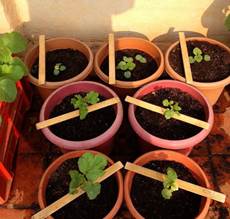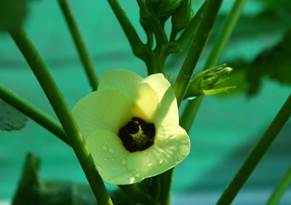How to grow Okra?
Okra Overview
Okra, is a tall-growing, warm-season, annual vegetable from the same family as hollyhock, rose of Sharon and hibiscus. This document focuses on growing Okras.
Table 1 Planting Guide
|
Depth to plant |
1 inches deep |
|
Spacing between seeds |
Space seeds about 24'' apart |
|
Spacing between seedlings |
Space seedlings about 12' |
|
Days to germinate (Sprout) |
7-21 days |
|
Planting season |
Summer |
|
Plant height |
Approx 6' - 8' tall |
|
No. of plants per sq. ft. |
1 plant per sq. ft. |
|
Soil requirement |
Prefers soil rich with pH levels of 6.0 to 7.6 |
Okra Prerequisites
- Plant Type: Perennial grown as an annual plant.
- Light: Full Sun
- Water: When it comes to watering okras in container gardens, keep the potting soil constantly moist
Okra Growing Steps
The following steps define the process from seed to harvest.
1. You must directly sow the heirloom seeds of okras from My Green Vault in containers. You can create a mini greenhouse effect by covering the seedling with a PET bottle which is cut at the base.

2. You can remove the covering once the plants have reached at least 1/2-foot in height.

Tip: By placing small sticks on your containers, you can avoid cats and birds lying on your pots and meddling with the seedlings.
3. Prepare a good growing medium. A good, simple option is a mix of two parts potting soil, one part Coco Peat (CP) and one part Vermi Compost (VC). The soil and VC provides your plant with the nutrients it needs, while the CP mix retains the moisture.

4. Place your pot in a sunny location.

Okra Plant Maintenance
Okras require evenly moist soil to ensure the best and fast growth. Do not over water or allow the soil to dry out.
1. When your okras bloom, to help promote greater plant productivity, add adequate amount of VC or Compost Tea (CT).

Note: For more information on CT preparation and application, refer to ***.
2. Make sure your okras receive at least 1“-1 1/2” of water a week.
3. Once the soil has warmed, mulch around okras to retain soil moisture and an even growing temperature. You must also eliminate weeds when the plants are young
Okra Companion Plants
Melons, cucumbers, sweet peppers, eggplant.
Okra Plant Protection
Okra Pests
Okras can be attacked by the following:
- Aphids
- Fruit borer
- Leaf hopper
- White flies
- Ash weevil
Okra Diseases
- Damping off and Nematode
- Yellow vein mosaic virus
- Powdery mildew
Okra Organic Control
Once you have identified the troublemakers, you can control them with an assortment of organic pest-control methods. The following list contains few methods:
a. Fruit borer
– Set up pheromone trap at 12 numbers per hectare.
– Remove the affected fruits and destroy
b. Leaf hopper
– Spray Neem oil or insecticidal soap solution
c. White flies
– Monitor the whitefly with yellow sticky trap
– Spray Neem oil
Note: For more information on Neem oil dilution and application, refer to ***. d. Damping off and Nematode
– Treat the seeds with Trichoderma viride or Pseudomonas fluorescens 24 hours before sowing
– Apply Pseudomonas fluorescens as soil application
– Avoid water stagnation
e. Aphids
– Spray home made garlic and insecticidal soap solution
Note: For more information on preparation and application of garlic and insecticidal soap spray, refer to ***.
f. Ash weevil
– Pour 4% Neem Seed Kernel Extract (NSKE) to soak the severely affected plant’s root system
– Apply Neem cake at the plant base
g. Yellow vein mosaic virus
– Remove and destroy all infected plants
– Use of disease resistant varieties
h. Powdery mildew
– Prune or stake plants to improve air circulation
– Water only in the morning so plants have a chance to dry during the day
Okra Harvesting
Your organic okras are ready for harvest when the pods are 2 to 4 inches long. They get very tough and stringy if allowed to stay on the plant.

The time from planting to harvest is 50 to 60 days from seeds. Keep cutting the pods every day or two, and they will keep on coming!

